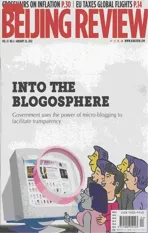Innovation Blooms
2012-10-16本刊编辑部
Innovation Blooms
As China gears up to rebalance its economy in its quest for more sustainable growth, innovation is proving to be a pivotal source of economic dynamism. How should China spur innovation? What problems are impeding the innovation process? Economists, government of fi cials and industry insiders discussed these issues at the annual economic forum of the Guanghua School of Management, Peking University on January 8 in Beijing. Edited excerpts of their views follow:
An urgent task
Li Yining, professor at Guanghua School of Management, Peking University: As China embarks on a more sustainable path of growth, economic rebalancing has taken center stage, and a vital goal of this campaign is to foster innovation and increase value creations in a string of industries.
To promote business innovations, there are several effective measures that the country should take.
First, it should create a fair market environment. The country needs to eliminate discrimination against smaller private firms and allow them to compete on an equal footing with large corporations. This should be able to boost con fi dence of entrepreneurs and foster creativeness among private businesses.
Second, policymakers should hand out policy incentives, such as favorable tax policies, government purchase and credit support.
Third, the country should improve the intellectual property right (IPR) protection system. China has formulated a set of rules and laws to crack down on IPR infringements,but stiff efforts are still needed to strengthen implementation of those rules and tighten punishments for violations.
Fourth, it should encourage state-owned enterprises to increase investments in experiments and applications of new technologies.
Progress underway
Zhang Xiaoqiang, Vice Chairman of the National Development and Reform Commission: China has been making remarkable progress on the road of innovation,though we still have a long way to go before catching up with advanced economies.
In 2011, China’s inputs in research and development (R&D) accounted for 1.83 percent of its GDP, up 0.63 percentage points from 2005.In addition, China has topped the world in terms of its wind power generation capacities and solar battery output. The information technology and bio-tech industries have also been growing at an annual rate of more than 30 percent.
As part of its 12th Five-Year Plan (2011-15), China has pledged to push into strategic emerging sectors including new materials,biotechnology and energy conservation and environmental protection.
The rapidly expanding domestic market is providing growth opportunities for innovationdriven enterprises. For example, the country is even expected to replace the United States as the world’s largest personal computer market in 2012 with sales of at least 85 million units.
Nevertheless, there are still a number of acute problems confronting the economy.
First, Chinese firms lack the ability to apply their technological research in real businesses. Every year, China registers tens of thousands of technological patents, but barely 10 percent of them make the cut.
Second, a serious concern lies in a lack of core technologies, such as high-end chips and basic software. The biggest reason is a shortage of research talent. So the country has to rely on imports for some key equipment and this de fi ciency puts Chinese fi rms in a weak position in global competitions.
Third, start-up businesses usually face fi nancing dif fi culties due to fl edgling fi nancial markets and insufficient fiscal support from the government.
Indigenous innovation requires international cooperation. As a result, China should encourage domestic companies to acquire overseas advanced technologies or learn research prowess through joint ventures. It is also necessary to encourage foreign companies to set up R&D centers in China to promote the country as a global R&D hotbed.
Auto innovation
Xu Heyi, Chairman of Beijing Automotive Industry Holding Corp.: China’s auto industry is switching gears despite sluggish sales in recent months. A brighter future is underway due to relatively low per-capita auto ownership in the country.
But Chinese auto manufacturers still have a lot to do to solidify their market foothold. In terms of market share, domestic brands have been lagging far behind their foreign counterparts.
To get out of this mess, we need to innovate our way out. Creative technologies and business models could sharpen the companies’ competitive edge and build customer loyalty. To achieve that, we must learn through international cooperation, joint ventures, or even technology acquisitions.
Self-owned domestic brands and newenergy vehicles will be two major focuses for innovation of China’s auto companies. Some fi rms have made signi fi cant breakthroughs in research into electric vehicles and hybrid cars. But still, vigorous efforts are needed to realize commercialization of those pioneering technologies and at the same time boost customer acceptance.
Another reason for concern is that domestic manufacturers of auto parts have weak innovation capabilities. Core technologies of engines and transmission parts are in the hands of foreign giants. That makes it dif fi cult for auto producers to improve product quality and compete in global markets.
The government could play a bigger role in facilitating innovation in the auto industry.Policymakers should enhance inputs in that area and map out a feasible blueprint for longterm development.
Entrepreneurship matters
Sun Taoran, President of Beijing Lakala Services Co. Ltd.: A growing number of Chinese people are starting their own businesses and looking to expand their operations.That is an encouraging development and a needed boon for employment and the broader economy.

HOT TOPIC:Participants discuss innovation and economic rebalancing at the annual economic forum of the Guanghua School of Management,Peking University
China has an improving environment for entrepreneurship as the huge population and a wealth boom create increasing market opportunities. Moreover, the government has spared no effort to provide assistance, including tax reductions.
Of course, not everyone can succeed because entrepreneurship requires great courage and risk awareness. But the most important factors are creative ideas and determination to implement them.
In China, many entrepreneurs tend to copy foreign companies’ business models. Those businesses can hardly sustain themselves due to fierce competition and a lack of core competitiveness. For example, group-buying websites are mushrooming across the nation, but very few are able to make ends meet.
Capital shortage is usually the biggest problem for many start-up businesses. It is difficult for small businesses to obtain bank loans or receive venture capital investments or angel investments. From my experience,investors would only favor the most talented entrepreneurs and the most promising sectors.
If a business owner can luckily receive investments, he needs to properly handle his relations with the investor. In exchange for capital injection, the investor would require a board seat and larger say in the corporate operation. But the entrepreneur should not completely follow the investor’s suggestions for corporate strategy. Instead, he must have ideas of his own and make decisions that are in the best interest of the company.
Failure is the unfortunate but probable outcome for most start-up businesses. Our society should be more tolerant of failed entrepreneurs. Also, the country needs to offer greater support, such as building a better social safety net, so entrepreneurs do not have to worry about their livelihood even if they fail.
“Indigenous innovation requires international cooperation. As a result, China should encourage domestic companies to acquire overseas advanced technologies or learn research prowess through joint ventures.”
—Zhang Xiaoqiang, Vice Chairman of the National Development and Reform Commission
